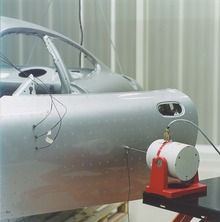Modal analysis


Modal analysisis the study of the dynamic properties of systems in thefrequency domain.It consists of mechanically exciting a studied component in such a way to target themodeshapesof the structure, and recording the vibration data with a network of sensors. Examples would include measuring the vibration of a car's body when it is attached to ashaker,or thenoise patternin a room when excited by a loudspeaker.
Modern day experimental modal analysis systems are composed of 1) sensors such astransducers(typicallyaccelerometers,load cells), or non contact via aLaser vibrometer,orstereophotogrammetric cameras2) data acquisition system and an analog-to-digital converter front end (todigitizeanaloginstrumentation signals) and 3) host PC (personal computer) to view the data and analyze it.
Classically this was done with a SIMO (single-input, multiple-output) approach, that is, one excitation point, and then the response is measured at many other points. In the past a hammer survey, using a fixed accelerometer and a roving hammer as excitation, gave a MISO (multiple-input, single-output) analysis, which is mathematically identical to SIMO, due to the principle ofreciprocity.In recent years MIMO (multi-input, multiple-output) have become more practical, wherepartial coherence analysisidentifies which part of the response comes from which excitation source. Using multiple shakers leads to a uniform distribution of the energy over the entire structure and a better coherence in the measurement. A single shaker may not effectively excite all the modes of a structure.[1]
Typical excitation signals can be classed asimpulse,broadband,sweptsine,chirp, and possibly others. Each has its own advantages and disadvantages.
The analysis of the signals typically relies onFourier analysis.The resultingtransfer functionwill show one or moreresonances,whose characteristicmass,frequencyanddamping ratiocan be estimated from the measurements.
The animated display of the mode shape is very useful toNVH (noise, vibration, and harshness)engineers.
The results can also be used to correlate withfinite element analysisnormal mode solutions.
Structures
[edit]Instructural engineering,modal analysis uses the overall mass and stiffness of a structure to find the various periods at which it will naturally resonate. These periods of vibration are very important to note inearthquake engineering,as it is imperative that a building's natural frequency does not match thefrequencyof expected earthquakes in the region in which the building is to be constructed. If a structure's natural frequency matches an earthquake's frequency[citation needed],the structure may continue toresonateand experience structural damage. Modal analysis is also important in structures such as bridges where the engineer should attempt to keep the natural frequencies away from the frequencies of people walking on the bridge. This may not be possible and for this reasons when groups of people are to walk along a bridge, for example a group of soldiers, the recommendation is that they break their step to avoid possibly significant excitation frequencies. Other natural excitation frequencies may exist and may excite a bridge's natural modes. Engineers tend to learn from such examples (at least in the short term) and more modern suspension bridges take account of the potential influence of wind through the shape of the deck, which might be designed in aerodynamic terms to pull the deck down against the support of the structure rather than allow it to lift. Other aerodynamic loading issues are dealt with by minimizing the area of the structure projected to the oncoming wind and to reduce wind generated oscillations of, for example, the hangers in suspension bridges.
Although modal analysis is usually carried out bycomputers,it is possible to hand-calculate the period ofvibrationof any high-rise building through idealization as a fixed-ended cantilever with lumped masses.
Electrodynamics
[edit]The basic idea of a modal analysis inelectrodynamicsis the same as in mechanics. The application is to determine which electromagnetic wave modes can stand or propagate within conducting enclosures such aswaveguidesorresonators.
Superposition of modes
[edit]Once a set of modes has been calculated for a system, the response to any kind of excitation can be calculated as a superposition of modes. This means that the response is the sum of the different mode shapes each one vibrating at its frequency. The weighting coefficients of this sum depend on the initial conditions and on the input signal.
Reciprocity
[edit]If the response is measured at point B in direction x (for example), for an excitation at point A in direction y, then the transfer function (crudely Bx/Ay in the frequency domain) is identical to that which is obtained when the response at Ay is measured when excited at Bx. That is Bx/Ay=Ay/Bx. Again this assumes (and is a good test for) linearity. (Furthermore, this assumes restricted types of damping and restricted types of active feedback.)
Identification methods
[edit]Identification methods are the mathematical backbone of modal analysis. They allow, throughlinear algebra,specifically throughleast square methodsto fit large amounts of data to find the modal constants (modal mass, modal stiffness modal damping) of the system. The methods are divided on the basis of the kind of system they aim to study inSDOF( single degree of freedom) methods and MDOF (multiple degree of freedom systems) methods and on the basis of the domain in which the data fitting takes place intime domainmethods andfrequency domainmethods.
See also
[edit]- Frequency analysis
- Modal analysis using FEM
- Modeshape
- Eigenanalysis
- Structural dynamics
- Vibration
- Modal testing
- Seismic performance analysis
References
[edit]- D. J. Ewins:Modal Testing: Theory, Practice and Application
- Jimin He, Zhi-Fang Fu (2001).Modal Analysis,Butterworth-Heinemann.ISBN0-7506-5079-6.
